The Mount Of Olives
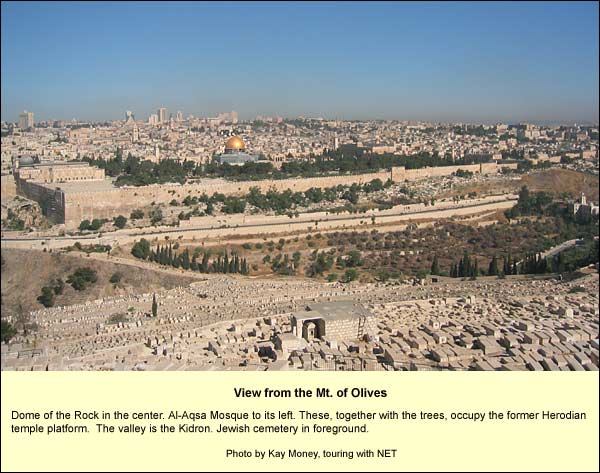
At the center of vision is the Dome of the Rock, commemorating Muhammad's ascent into heaven. It probably stands, we shall see, where the Temple stood. Beyond it, to the north, west and south, spreads a city of 900,000 people. In antiquity Jewish pilgrims, on reaching the top of Olivet and seeing the goal of their journey before them, would sing Psalm 122.
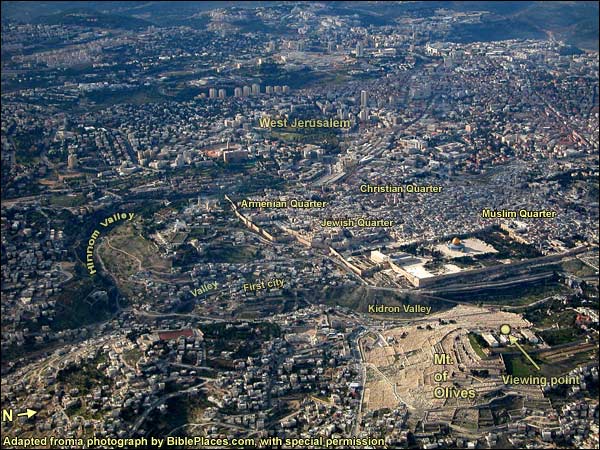
The area including the golden Dome of the Rock and the al-Aqsa Mosque is known in Arabic as the Noble Sanctuary (Haram es-Sharif). Jews and Christians also refer to it as the Temple Mount. In the picture below, beyond al-Aqsa we see the buildings of the Jewish Quarter, behind which lies the Armenian quarter. Beyond the Dome of the Rock is the large gray dome of the Holy Sepulcher, around which huddles the Christian Quarter. The Haram, with the area to its right, is the Muslim quarter.
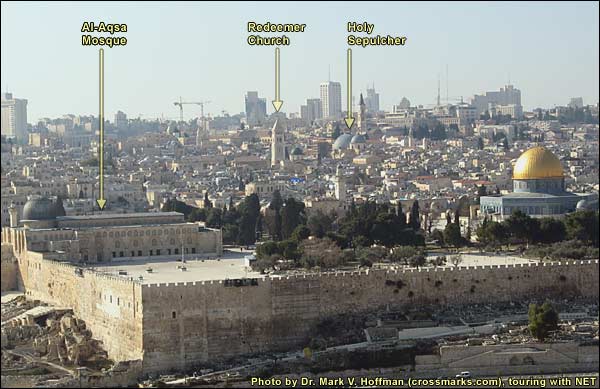
Before 1850, Jerusalem existed only within what we today call the Old City walls. Standing here, say, in 1849, we would have seen just landscape around those walls, as well as a caravanserai and perhaps the occasional ruin of a church.
Here is a photograph from the opposite angle, taken at a time when al-Aqsa's dome was silver. Note that the Mt. of Olives forms a barrier between Jerusalem and the wilderness.
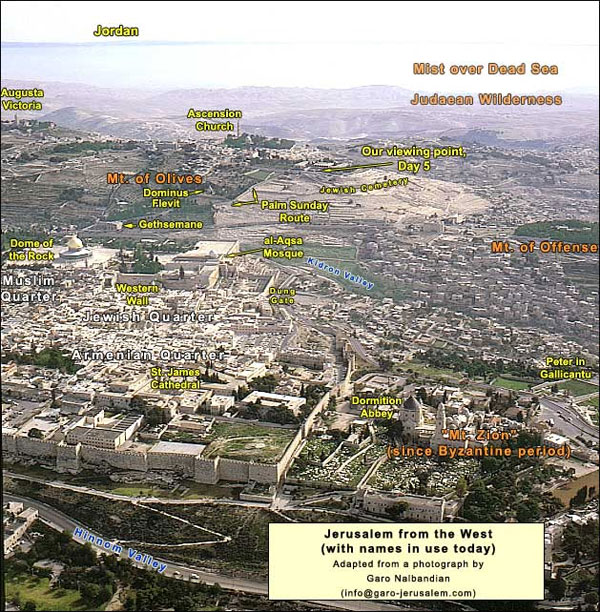
If you want a closer view from this side, enlarge the photo on the left.
Of the many themes on the Mount of Olives, we pick out several (see the Article Index on this page). From here as nowhere else we can trace the development of ancient Jerusalem. Also, as mentioned, it is the mountain over which - says prophetic tradition - the Messiah will arrive. That tradition stands behind the decision of Jesus to enter Jerusalem over this mountain. He is said to have taught the Lord's Prayer on its peak, and Acts records that from here he ascended. At the mountain's foot is the "place of the olive press" - gat shemanim, Gethsemane. And here we find Jewish cemeteries, ancient and modern.
{mospagebreak title=City Of David}
The first Jerusalem and the City of David:
Historical Geography
[The following article deals with the first Jerusalem as seen from the Mount of Olives. For our more complete coverage, see here.]
We can locate the original Jerusalem from the Mt. of Olives. We must look south of the golden Dome of the Rock, to the left of the bend in the modern street, outside the present Old City walls. Three houses left of that bend, we find what was probably the northernmost point of the pre-Solomonic city (see photo, below). From there, that is, Jerusalem extended to the left (south), on the ridge. If the open palm of the right hand represents the Old City, then the original Jerusalem is the last two sections of the pinky.
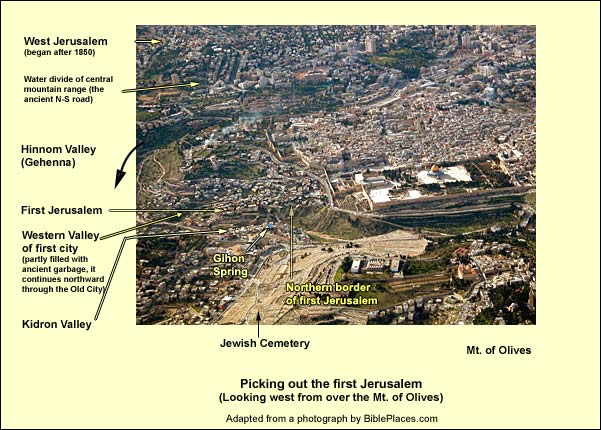
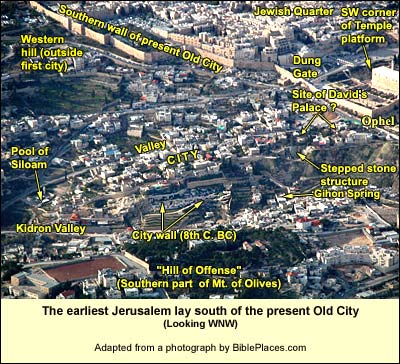
Note that the original Jerusalem was protected by deep valleys. These were the Kidron and an unnamed valley.In the 1st century AD, Josephus calls this valley the Tyropoeon or "Cheesemakers" Valley, but the expression may have been a euphemism relating to the same smell that would later give the Dung Gate its name. Cheese would not have been made in the city, rather at the sites where the livestock lived. The latter has been largely filled in by garbage and sewage, but in antiquity it was deep. The 2009 excavations show that it angles southwest from the Dung Gate;
there is evidence of habitation on the city's western slope as early as
the 9th century BC. (After the city expanded to include the western hill, this valley ran through its middle.) A third valley stretched from the early city's southern tip westward. This is the Hinnom, Gai Benai Hinnom in Hebrew, which came to be called Gehenna (associated with hell)Gai b'neh hinnom in Greek became Gehenna – an equivalent of hell. The association may have arisen out of 2 Kings 23:10, which lists the reforms of King Josiah: "He defiled Topheth, which is in the valley of the children of Hinnom, that no man might make his son or his daughter to pass through the fire to Molech." (Cf. Isaiah 30:33 and Jeremiah 7: 31-33). The associaton with hell became further established in Jewish apocalyptic literature: 4 Ezra 7:36, "The furnace of Gehenna shall be made manifest, and over against it the Paradise of Delight.". Thus the original Jerusalem, about 300 yards north-south by 80 east-west, had excellent natural defenses on all sides except for its narrow north. Here the hill sloped upward, forcing the city's first residents to build a high wall against potential archers. This hill can be considered part of the plateau of Benjamin (to be discussed shortly).
We can see the defensive problem by studying the contours that Charles Wilson was able to determine in the 19th century, thanks to the Ottoman sultan's permission for probes and soundings:
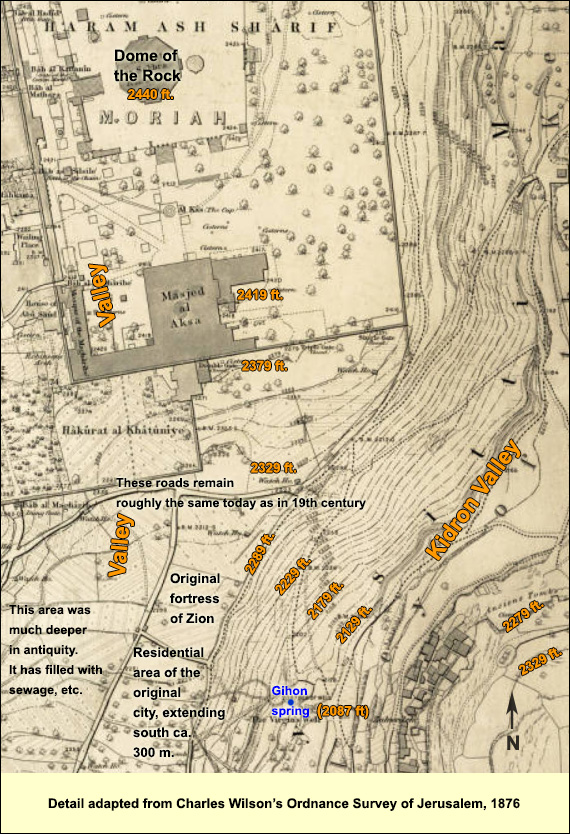
Here is a view from the south:
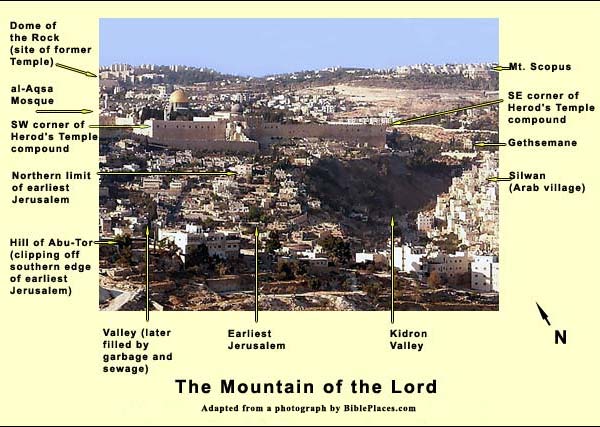
Jerusalem had a spring, the Gihon or "gusher," which is located today in an opening just beneath the floor of the Kidron Valley. (The Kidron was deeper in David's time.) The Gihon can supply about 2500 people. But we should also remember that the city was surrounded by watersheds (a major one on the north and west, but another formed by the ridge of the Mount of Olives on the east), so that there would have been run-off from three sides to fill its cisterns.
Here is a view of the Old City and the Mount of Olives from the west:
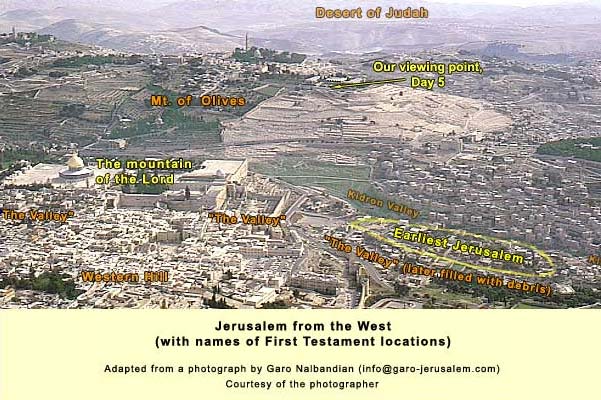
It has become fashionable to point out what a tiny village Jerusalem was in the time of David and Solomon. Indeed the spur is small. Yet the settlements nearby were much smaller, and the other cities on the central mountain range were not as well defended by valleys.
Jerusalem was already important enough 800 years before David to attract an Egyptian curse in the Execration Texts.The Egyptians wrote the names of their enemies on clay figures, which they then smashed or maltreated, hoping that a similar fate would befall those designated.
What made this first Jerusalem important? The answer includes two factors.
First, on its north side begins a plateau (10 miles south-to-north by 4 miles east-to-west). Since most of it belonged to the tribe of Benjamin, we can call it the Benjamin plateau. The southernmost good link road between the international trade routes here met the only north-south route in the central highlands. This link road used an unbroken ridge (rare in these parts), ascending from the west through Beth Horon toward Gibeon on the plateau, then descending to Jericho and crossing the Jordan to Heshbon on the King's Highway.
The photograph (right) shows the western part of the ridge road, not included in the map above.
Armies coming from the west to attack Jerusalem tended to take this unbroken ridge road, reaching the plateau and turning south: for example, the Seleucids on their second attempt to quell the Maccabean revolt, the Romans under Cestius Gallus, the Crusaders, and the British in 1917.
We have already seen the second reason for Jerusalem's early importance: Many other cities enjoyed the commercial advantages of the central Benjamin plateau: Bethel, Beeroth, Mizpah, Rama, Gibeon, and Gibeah, while Jerusalem clung to its southern edge. But although these other towns were closer to the intersections, only Jerusalem had deep valleys for defense.
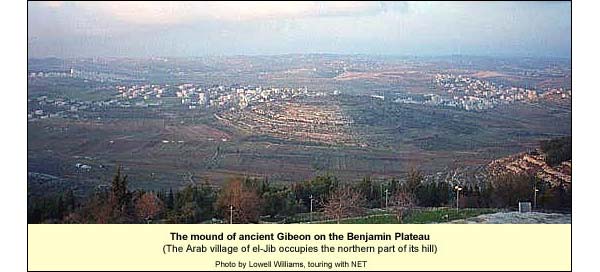
Jerusalem's access to the Benjamin plateau, combined with its defensibility, were among the factors that led David to make it his capital.
David had other reasons too for choosing Jerusalem as his capital:
After the death of Saul, the whole land was exposed to the Philistines. David, chief of a warrior band, went up to Hebron and ruled Judah. Hebron is ideally situated for controlling the southern quarter of the central highlands, but no more than that. According to 2 Samuel 5: 1-3, after seven years, in response to the Philistine threat, the other tribes asked David to rule over them. Hebron would not be suitable as a capital for such an expanded kingdom: it lay too far south, and its connection with the north was tenuous. Now David cast his eye on Jerusalem: it bordered his home tribe of Judah, and it gave him access to the Benjamin plateau. From here he could connect to all points. On the other hand, if he let it fall to the Philistines, he would be blocked from contact with the north. This particular Philistine threat may have been his principal motive, as KeelOthmar Keel, Die Geschichte Jerusalems und die Entstehung des Monotheismus, Göttingen: Vandenhoeck & Ruprecht, 2007, p. 171. suggests. Concerning the conquest, we read in 2 Samuel 5:6 that Jerusalem belonged to the Jebusites. When David and his forces arrived, "the Jebusite" taunted him, saying that the lame and the blind would suffice to keep him out of the city. Verse 7 says: "And David captured the Fortress of Zion, it is the City of David." (The word for "captured" can mean "ensnared.") And the next verse reads (sticking close to the Hebrew):
And David said on that day, "Whoever strikes a Jebusite and touches (v'yigga) the tzinnor,The meaning is unknown. In the biblical text, tzinnor occurs only here and in Psalms 42:8, where it seems to mean something associated with water, such as a waterspout. and the lame and the blind are hated of David's soul, which is why it is said that a lame or a blind personThe verse probably refers to the fact that, as stated in Leviticus 21:17-18, Aaron's descendants who were lame or blind or had certain other physical challenges were excluded from officiating as priests in the temple. Otherwise, the lame and the blind had the same access to the temple as all Israelites: In Matthew 21:14, we learn that that lame and the blind came to Jesus in the temple, and he healed them. shall not enter the house." If the sentence about "Whoever strikes a Jebusite" sounds ungrammatical, well, it is! Usually the verse is taken to explain how David conquered the city. But notice the gap after tzinnor. No verb follows the subject-clause ("Whoever..."). Elsewhere in the Bible such a phrase introduces an expression like, "...will be put to death" (Exodus 21:12-17). One might then take the three verses, 6-8, as a chronological sequence: (6) David is taunted; (7) David ensnares the city; (8) David at once issues an edict forbidding his soldiers to harm a Jebusite or touch the tzinnor. This interpretation fits well with the fact that Jebusites continued to live in the City of David. We know they remained because David later bought a threshing floor from Araunah the Jebusite on the peak of the city's hill and erected an altar to Yahweh there (2 Samuel 24:16-25). It is remarkable that the Araunah story survived: According to Deuteronomy 7:1ff.; 20:17 (cf. Joshua 6:21) all non-Israelites were to be driven from the land or killed, and this view clearly guided the editor of the so-called Deuteronomic history (Joshua, Judges, Samuel, Kings). A continued presence of non-Israelites in Jerusalem was an embarrassment for the editor (as in Jericho and Gibeon, where suitable stories explain the anomaly). Perhaps, that is why we do not hear of any other Jebusites by name in the city (this may also explain the above-mentioned gap in the Hebrew of 2 Samuel 5:8). But it is noteworthy, as KeelOthmar Keel, Die Geschichte Jerusalems und die Entstehung des Monotheismus, Göttingen: Vandenhoeck & Ruprecht, 2007, pp. 171ff., 188-89. points out, that after David arrives in Jerusalem from Hebron, he gets an additional high priest (Zadok) to the one he had in Hebron (Aviathar) and an additional military commander (Benayah) to the one he had in Hebron (Joab).In 1 Chronicles 11:6, written centuries later, David adds that the leader of the attack will be head of the army, and this turns out to be Joab, who is already head of the army. Keel believes that the new, additional leaders were veteran Jerusalemites. He also counts Bathsheba and the prophet Nathan in this group. On such a view, the "capture" of the city may have involved an agreement: many of the Jebusites might well have preferred David's rule over the only alternative: the Philistines. ("The Jebusite" [singular] who taunted David may have represented an opposing faction.) On "ensnaring" the city, David amalgamated his Hebron cabinet with part of the existing Jerusalem (Jebusite) leadership. He managed to hold the two groups together until his death, when the veteran Jerusalemites, led by Bathsheba's son Solomon, defeated the Hebron crowd (Adonijah and Joab were murdered, Aviathar exiled). By force or accommodation or a little of both, David assumed power in Jerusalem and made it his capital. Solomon built the Temple there. This was destroyed by the Babylonians in 586 BC but restored 70 years later by returning Jewish exiles. In 23 BC, Herod began to rebuild it in grander style. To this city and its Temple Jesus made pilgrimage around 30 AD, followed by the many pilgrims who came in his footsteps starting 250 years later. Several centuries after that, Muslims identified Jerusalem as the place of Muhammad's ascent into heaven. All these traditions have led to the growth of the metropolis that we see today.
{mospagebreak title=Solomon to Herod}
Jerusalem from Solomon to Herod, as seen from the Mt. of Olives
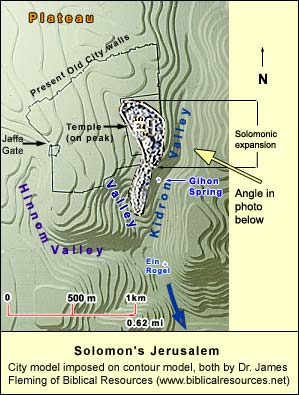
Extending northward from the ridge of the original Jerusalem is the hill upon which Solomon built the Temple. There has been no archaeological excavation in the inner area of the Temple, but an informed guess is that the sanctuary containing the Holy of Holies stood where the Dome of the Rock is today.
Solomon surrounded the Temple with a wall. Its north side (where the city lacked a deep valley defending it) probably ran along the north side of the platform with the arches. (A moat just north of this platform may have been dug at this time.) There would be little point in such expansion, however, unless there was a large enough army in the city to defend this longer wall. For Solomon's reign was one of internal dissent (see 1 Kings 11:14-40), which led to the split in the kingdom after his death.
Since the chief water source, the Gihon Spring, could only support about 2500 people, one wonders how Solomon managed so great an expansion. Where would he have gotten water to supply the population that would have been needed to produce and support enough soldiers to defend the longer wall? He may of course have used mercenaries, as his father David had, but mercenaries too have families.
It is possible, of course, that Solomon did not expand so far to the north and that his temple was not where the consensus puts it. For evidence on this location we have only JosephusJosephus Flavius (36 – 100 AD), Jewish general, one of two directing the revolt against Rome in Galilee. He later turned historian, writing The Jewish War, The Antiquities of the Jews and many other books. Because of a paragraph about John the Baptist (and maybe a sentence about Jesus), the Church preserved his works., who is often dead wrong, plus the archaeologically established fact that the Herodian temple was in the expanded area.
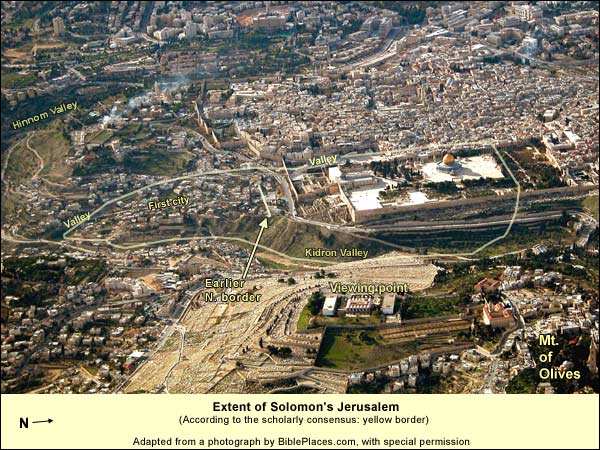
These then were the dimensions of Jerusalem down to the time of King Hezekiah. It was the city that the prophet Isaiah referred to as Zion.
In the 8th century BC, Assyria expanded, conquering much of the Levant, including the northern kingdom of Israel. Those areas that retained independence had to pay heavy tribute. When Sargon II of Assyria died in 705, the tribute-payers, among them Hezekiah of Judah, prepared a revolt. Knowing that the Assyrian army would soon be approaching, Hezekiah took measures: he stored up supplies in the cities and readied them to absorb large numbers of refugees from the villages. In Jerusalem, he extended the wall to the hill on the other side of the valley later known as the Tyropoeon (Cheesemakers') Valley. Pieces of this wall have been exposed in the Jewish quarter, but it is not yet clear how far to the west the expanded city went.
This larger Jerusalem needed more water. It was Hezekiah, apparently, who had a basin dug in a valley north of the Temple (cf. 2 Kings 18:17The king of Assyria sent Tartan and Rabsaris and Rabshakeh from Lachish to king Hezekiah with a great army to Jerusalem. They went up and came to Jerusalem. When they had come up, they came and stood by the conduit of the upper pool, which is in the highway of the fuller’s field.). It later became the northern basin of the Pool of Bethesda.
Hezekiah also had a winding tunnel excavated, leading the water of the Gihon spring 1750 feet to a pool in the south, far enough from the Mt. of Olives that a wall could protect the water-drawers from Assyrian arrows.
Jerusalem survived the Assyrian attack, though again by paying heavy tribute. It did not survive the Babylonians, however, in 586 BC. The Temple was destroyed, and the people went into exile.
The Period of the Second Temple
When Cyrus of Persia conquered Babylon, he published an edict (538 BC) allowing the Jews to return. Both Temple and city were rebuilt on a modest scale. Jerusalem does not seem to have extended beyond the old Solomonic boundaries.
After Alexander defeated the Persians, his successors in Egypt, the Ptolemies, took over the land, including Jerusalem and the Temple. In 200 BC, however, they lost it to Alexander's successors in Syria, the SeleucidsAfter the death of Alexander the Great (323 BC), his successors Ptolemy and Seleucus became rivals for the huge area he had conquered. The former took Egypt, the latter much of Iran, Asia Minor, Mesopotamia and Syria. At first the Egypt-based Ptolemies ruled the biblical land, but around 200 BC, the Seleucid Antiochus III inflicted a major defeat on them at Banias, enabling him to take over the country.. Sensitive to the rising power of Rome and encouraged by Hellenizing Jews, the Seleucid ruler, Antiochus Epiphanes IV, sought to homogenize his empire. He tried to bring the Jews into line with the dominant pagan cult. He took over Jerusalem, sacrificing a pig on the altar of the Temple. Five brothers from the priestly house of Hasmon, known as the Maccabees, launched a revolt.
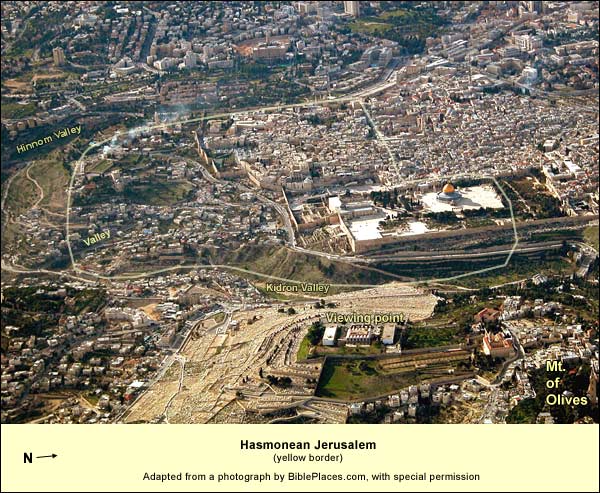
These HasmoneansThe family of Judah Maccabaeus ("the hammerer") and his brothers, who revolted successfully against the Greek Empire in 167 BC. They purified and re-dedicated the Temple in Jerusalem, establishing the festival of Hanukah ("dedication"). They ruled till 63 BC, and their domain extended almost as far as King David's. captured Jerusalem from the Seleucids in 164 BC. They re-dedicated the Temple, inaugurating the festival of Hanukah (Hebrew for "dedication"). In the following decades, they expanded the city to its natural defense lines: the Hinnom Valley on the south and west and the Kidron on the east. If we could shove the present Old City south a bit and perch its southern wall over the Hinnom, we would almost have it. To this much larger Jerusalem, the Hasmoneans would have had to bring water. Since they had the technology of the aqueduct, we may assume that they were the ones who first led water to Jerusalem from a strong spring south of Bethlehem, in the area known as Solomon's Pools.
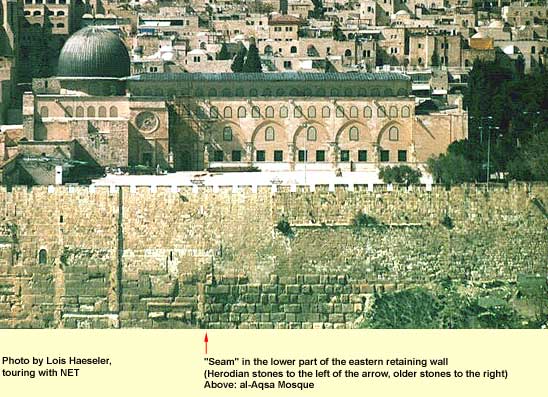
Taking over in 37 BC, Herod made Jerusalem the focus of great projects. He received permission from the Jewish priests to tear down the modest Second Temple and build it anew. He expanded its platforms on all sides except the east, where the hill slopes steeply to the Kidron. We can see this older eastern wall in the photo above. If we start at its southern corner, then follow the lower courses 105 feet to the right (north), we note a sudden change in the way the stones are cut. Those 105 feet were Herod's addition. The lower courses north of it are probably Hasmonean, maybe older. This was the outer wall of "Solomon's portico," where Jesus taughtJohn 10:22-23: It was the Feast of the Dedication [Hanukah] at Jerusalem. It was winter, and Jesus was walking in the temple, in Solomon's portico..
Herod tore down much of the Hasmonean city, rebuilding it in grand Hellenistic style. He built an additional wall, extending Jerusalem northward as far - it is thought - as today's Damascus Gate.
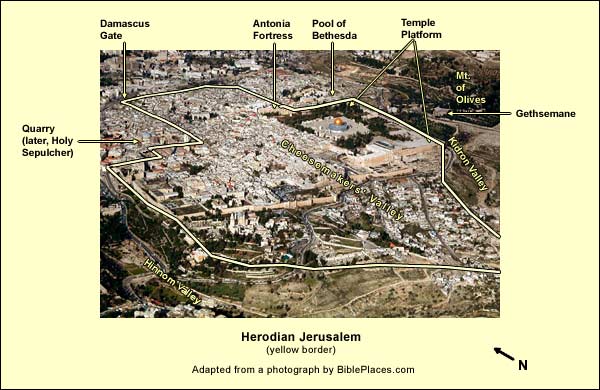
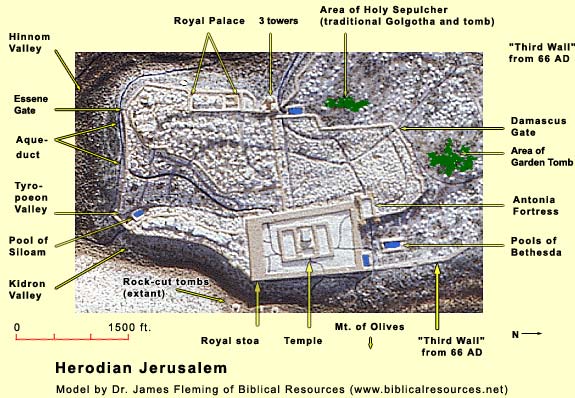
According to Josephus, Herod included a theatre and a hippodrome (neither has been found). The platform of his palace is on the Old City's west side in today's Armenian quarter: it is almost a thousand feet long. Towers guarded it, three of them on its vulnerable north. The lower part of one is still there. The towers had names; this one was probably Hippicus or Phasael.
Later the procurators stayed in the palace when visiting Jerusalem. From JosephusJosephus Flavius (36 – 100 AD), Jewish general, one of two directing the revolt against Rome in Galilee. After Vespasian captured him, he prophesied the latter would be emperor. When this proved true, the Romans honored him. He then turned historian, writing The Jewish War, The Antiquities of the Jews and many other books. Because of a paragraph about John the Baptist (and maybe a sentence about Jesus), the Church preserved his works. we learn that in 66 AD, one of them set up his tribunal before it and condemned Jewish demonstrators to crucifixion. Since this was also the highest part of the Herodian city, some think it may have been the "Gabbatha" (Hebrew, high place) of the Gospel (John 19:13Therefore when Pilate heard these words, he brought Jesus out, and sat down on the judgment seat at a place called The Pavement, but in Hebrew, Gabbatha.), where Pilate condemned Jesus. In that case, the Via Dolorosa started there.
One important part of today's Old City was not within the Herodian walls: the area where we today see the Church of the Holy Sepulcher. We know it was not within the walls, because it contains graves from the Herodian period, and Jews do not and did not bury their dead inside their cities. This point will be important for the question of the Sepulcher's authenticity.
We return to Herod's Temple compound. It extended from the black-domed al-Aqsa Mosque of today (then a huge colonnaded stoa or portico) past the Dome of the Rock, as far as there are trees. At its northwest corner there is now a minaret; from it, stretching toward us, was the Antonia Fortress, high enough to be in visual contact with Phasael and the other towers on the west side. The Antonia had the double function of guarding against attacks from the north and enabling the ruler to supervise the Temple area, where protest demonstrations might start. Since the day of Jesus' trial was a Passover, according to the synoptic gospelsMatthew, Mark and Luke have many parallel passages and appear, therefore, to be closely related. They are called the synoptic Gospels from the Greek sun- ,"together," plus opsis, "view." , it makes sense that Pontius Pilate would have been here that morning, watching for trouble. Here is another possibility, then (the traditional one, in fact) for the beginning of the Via Dolorosa.
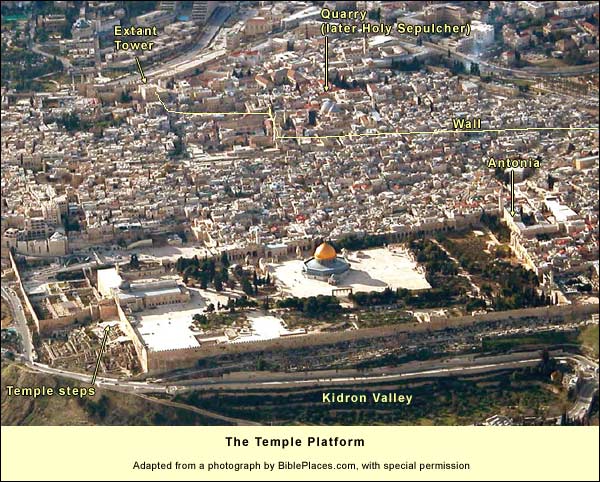
The platform was an irregular polygon, roughly 1500 feet long by 1000 wide. It was the biggest structure ever built as a single project, having 35 acres, large enough to accommodate 400,000 pilgrims, as sometimes it still does during Muslim festivals. The Temple compound took up a fifth of the city.
"Now the outward face of the temple in its front ...was covered all over with plates of gold of great weight, and, at the first rising of the sun, reflected back a very fiery splendor, and made those who forced themselves to look upon it to turn their eyes away, just as they would have done at the sun's own rays. But this temple appeared to strangers, when they were coming to it at a distance, like a mountain covered with snow; for as to those parts of it that were not gilt, they were exceeding white." (Josephus WarJosephus Flavius. The Jewish War. Translated by William Whiston., V 5.6.)
Such was the Temple and the city that Jesus saw on coming over the Mt. of Olives.
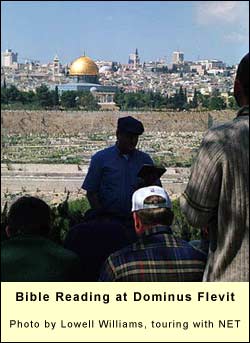
We walk partway down the Mt. of Olives and enter the grounds of the church with the black tear-drop dome, Dominus Flevit. This is a good place to read from the Bible. Ever since Zechariah (14:1-4) prophesied that "a day is coming for the Lord," people have associated the Mt. of Olives with the arrival of the Messiah: Behold, a day of Yahweh comes, when your spoil will be divided in your midst. cb(14,2); For I will gather all nations against Jerusalem to battle; and the city will be taken, the houses rifled, and the women ravished. Half of the city will go out into captivity, and the rest of the people will not be cut off from the city. cb(14,3); Then Yahweh will go out and fight against those nations, as when he fought in the day of battle. cb(14,4); His feet will stand in that day on the Mount of Olives, which is before Jerusalem on the east; and the Mount of Olives will be split in two, from east to west, making a very great valley. Half of the mountain will move toward the north, and half of it toward the south. cb(14,5); It was important, therefore, that Jesus, as the Messiah, should approach the city over this mountain. In fulfillment of Zechariah 9:9 Rejoice greatly, daughter of Zion! Shout, daughter of Jerusalem! Behold, your King comes to you! He is righteous, and having salvation; lowly, and riding on a donkey, even on a colt, the foal of a donkey., he does so riding on a donkey.
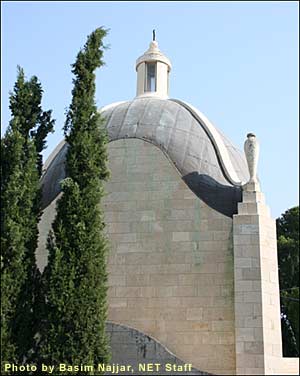
This is the best place to read about Jesus' entry on Palm Sunday in Luke 19. There, in verse 42, when Jesus says, "“If you, even you, had known today the things which belong to your peace!" there may be a reference to a verse from Psalm 122, which pilgrims used to sing on first seeing the city: "Pray for the peace of Jerusalem." There are also echoes in this passage of a dialogue from Psalm 118, between the priests at the Temple and the approaching pilgrims. John 12:12-13John 12:12: On the next day a great multitude had come to the feast. When they heard that Jesus was coming to Jerusalem,they took the branches of the palm trees, and went out to meet him, and cried out, “Hosanna! Blessed is he who comes in the name of the Lord, the King of Israel!” includes the palm fronds, giving us the tradition of Palm Sunday. Dominus Flevit ("The Lord weeps") This Roman Catholic church (1955) has a dome in the shape of a tear drop, with phials on the corners, such as the women of antiquity used in order to catch and store their tears. Well into building the church, the workers discovered ancient Jewish cemeteries, dating from the 1st century BC to the 5th AD. This was something of a disappointment. It meant that a main road would probably not have come through here: Jewish priests, many of whom lived in Jericho, would have had to use the road. If it had led through the cemetery, it would have rendered them impure for service.
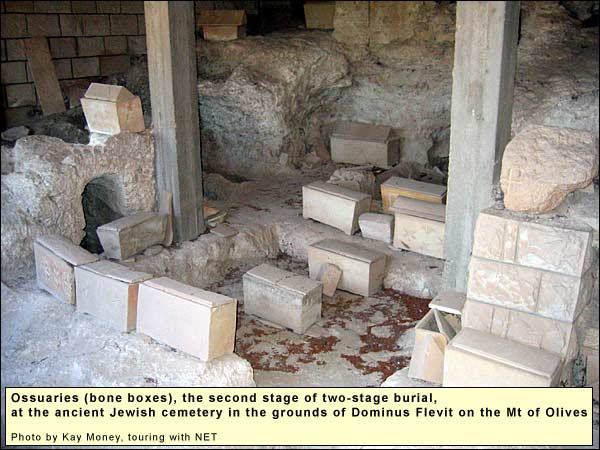
Dominus Flevit is built on the ruins of a 5th-century monastery. One of its mosaics, with an inscription offering a prayer on behalf of "Simeon, friend of Christ," is visible to the left just before entering the church. Inside, we can see the apse of the monastery chapel, facing east. The present church, however, has its apse facing west, because of the glorious view:
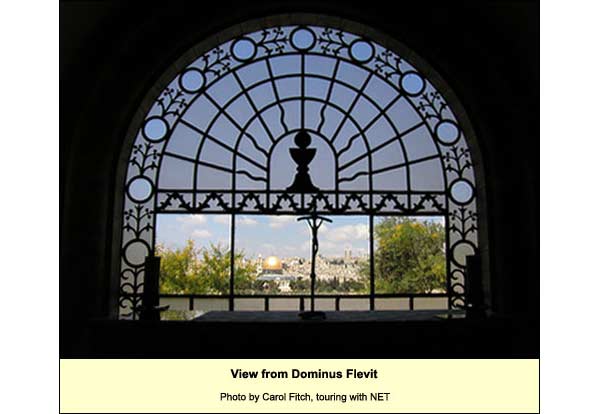
Logistics: Open 8.00 - 12.00, 14.30 - 17.00. Wear modest dressShoulders covered, legs covered below the knees.. There are rest rooms. {mospagebreak title=Pater Noster Church} The Pater Noster ("Our Father") Church and the Mosque of Jesus' Ascension Among the churches funded by the Byzantine Emperor ConstantineConstantine the Great (280? – 337AD). In 312 AD, he received, he believed, the help of the Christian God at a crucial battle, thus becoming ruler of the Roman empire's western half. A year later, in the Edict of Milan, he legalized Christianity. By 324 he ruled the Empire's eastern half as well. In 326 his immensely popular, 72-year-old mother Helena made a journey to the Holy Land, establishing the trend of Christian pilgrimage and – through her discovery of the true cross – founding the science of archaeology. With her son's support, she erected churches.In 330, having built up the ancient city of Byzantium as his new capital, Constantine renamed it Constantinople and dedicated it to the God of the Christians, whom he seems to have confused with himself. He delayed becoming a Christian till his last illness: few Christians then believed in post-baptismal forgiveness for serious sins., three were built over caves: that of the Nativity in Bethlehem, that of the Resurrection in Jerusalem (later called the Holy Sepulcher), and a Church of the Disciples and the Ascension on the Mount of Olives. A visitor known as the Bordeaux pilgrim reported seeing the third in 333. Yet in 384, according to Egeria, Christians were celebrating the ascension on higher ground about thirty yards to the north. Here, by 392, a small round church had been built. The cave in Constantine's basilica (now called Eleona, "of olives") came to be associated with something else that occurred on this mountain: Jesus' teaching about the final days as reported in Matthew 24:1 - 26:2. This was the text that Egeria heard here on Tuesday of Holy Week. (Murphy-O'ConnorJerome Murphy-O'Connor, The Holy Land: An Archaeological Guide, 4th edition, London: Oxford, 1998., p. 125.)
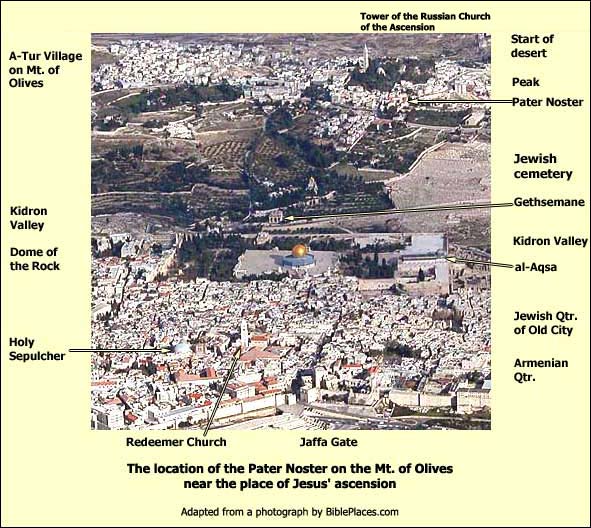
When the Persians broke through the bounds of the Byzantine Empire in 614, they destroyed both churches. The Byzantines, having regained control in 628, restored the one on the higher ground. The Eleona with its cave remained in ruins, it would seem, although the memory persisted that Jesus had taught here. A shift occurred, however, in the notion of what teaching he had delivered. It was now thought to be the Lord's Prayer. When Luke reports Jesus' teaching this prayer (11:1-4Luke 11:1-4:It happened, that when he finished praying in a certain place, one of his disciples said to him, “Lord, teach us to pray, just as John also taught his disciples.”He said to them, “When you pray, say,‘Our Father in heaven,may your name be kept holy.May your Kingdom come.May your will be done on Earth, as it is in heaven.Give us day by day our daily bread.Forgive us our sins,for we ourselves also forgive everyone who is indebted to us.Bring us not into temptation,but deliver us from the evil one."), he does not name a particular place. In Mark 11:25-26Whenever you stand praying, forgive, if you have anything against anyone; so that your Father, who is in heaven, may also forgive you your transgressions. But if you do not forgive, neither will your Father in heaven forgive your transgressions., however, while on the Mt. of Olives, Jesus says, "Whenever you stand praying, forgive, if you have anything against anyone; so that your Father, who is in heaven, may also forgive you your transgressions. But if you do not forgive, neither will your Father in heaven forgive your transgressions." Recognizing this as part of the prayer that is given in Luke, people located the whole prayer on the mountain, in the cave that already carried an association with Jesus' teaching. When the Crusaders erected a church here in the 12th century, they called it "Pater Noster." Crusader pilgrims reported seeing the Lord's Prayer inscribed on plaques. In 1868 an Italian woman, Aurelia Bossie, Princess de la Tour d'Auvergne, built a cloister here, on the inner wall of which she put 32 copies of the Lord's Prayer in different languages. Later she added a Carmelite convent. One sees her sarcophagus while passing through. In 1910 the French discovered the foundations of the Byzantine basilica with the cave that had been its focus. Part of the cloister was on top of them, and it was moved. The French then undertook to built a basilica on the model of Constantine's, but they never finished: hence the open space around the cave. This cave cuts into a shaft tomb (kokh) from the 1st century AD. Today the Lord's Prayer appears here in 110 languages. The Mosque of Ascension Just to the north, a bit higher, is the Mosque of the Ascension, which includes the place where the church of that name stood in 384. The fourth Sura of the Qur'an states that the Jews claimed to have killed Jesus (Isa), but Allah thwarted their plans, taking him up. There is no contradiction, then, in having a mosque that commemorates Jesus' ascension.
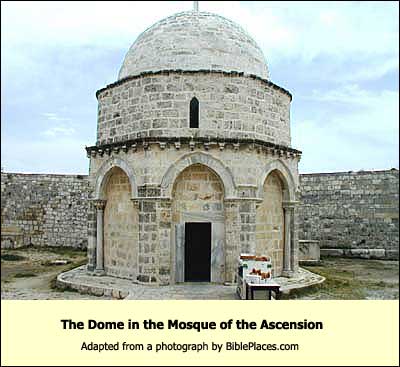
When we enter, on our right is a small mosque (built in 1620), from whose gallery one can get a view of the area. We descend and head through the open courtyard toward the central domed structure. High in the octagonal wall around the courtyard are hooks, which hold the awnings that shade the Christian congregants here on the Feast of Ascension (fortieth day after Easter). At the place of the dome, in 392, stood a church. After the Persian destruction in 614, the Byzantines restored it. A pilgrim named ArculfA Gallic bishop with a strong interest in architecture. He visited the holy land around 680 AD, bringing back sketches of buildings and descriptions of landscape. described it in 680 as a round structure, open to the sky, as befits the ascension of Jesus. In the dust of its floor, he wrote, were the indestructible footprints of Jesus. The Crusaders did some restoration work on the shrine, but after 1187 it passed into the hands of Saladin, whose followers rebuilt it with a dome. One of Jesus' footprints was then transferred to the al-Aqsa Mosque. Logistics: The Pater Noster Church is open as follows: Monday-Saturday, 8:30-11:45; 15:00-16:45 (Sunday closed). Wear modest dressShoulders covered, legs covered below the knees.. Mosque of the Ascension: If the door is not open, ring the bell. Modest dressShoulders covered, legs covered below the knees.. {mospagebreak title=Cemeteries} The Cemeteries, the Golden Gate and Judgment Day Spreading below us (and beneath the pavement we are standing on) is a large Jewish cemetery. People are buried in the ground; what seem like stone sarcophagi are grave monuments, each with a niche for a memorial candle. It is a Jewish custom, on visiting a grave, to leave a stone. No one knows the reason for this custom. There are many theories, among them this: In the time of the second Temple, the well-to-do were buried in caves, but the regular people could not afford a cave. They were buried, therefore, in the earth. It was important to mark the grave somehow, because to step on it would make one ritually impure, and one would have to undergo a complex ceremony before one could enter the precincts of the Temple. Since the poor could not afford a monument, they simply made a pile of stones over the grave, such as we see in the cemetery of Qumran.

On the slope of the HaramHaram es-Sharif, Arabic meaning "the Noble Sanctuary." This is the Muslim term for the area containing the Dome of the Rock and the al-Aqsa Mosque. Jews call it the Temple Mount., opposite, is a Muslim cemetery, and in the valley between, a Christian one. We may trace the Muslim presence to the belief that on Judgment Day, the shrine at Mecca known as the Ka'ba will be transported miraculously to the Haram, and the last judgement will take place here. The Jewish presence here too, as well as the Christian, hinges on biblical texts relating the place to the Day of the Lord. The Kidron Valley below us bears another name as well, that of King Jehoshaphat, meaning "yhwh judges" (preserved in Arabic as wadi joz). The prophet Joel (3:1-2) plays upon it: For, behold, in those days, and in that time, when I restore the fortunes of Judah and Jerusalem, cb(3,2);I will gather all nations, and will bring them down into the valley of Jehoshaphat; and I will execute judgment on them there for my people, and for my heritage, Israel, whom they have scattered among the nations. The Golden Gate
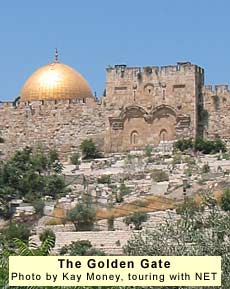
The Mt. of Olives contains ancient Jewish cemeteries, as at Dominus Flevit. Before the Crusaders arrived, however, most of the city's Jews were buried across from the mountain, on the slope near the Gate of Mercy (or Golden Gate), where the Muslim cemetery is today. In the eastern wall of the Haram, we can see this grand double-arched gate (filled in), probably built by the Muslims in the early 8th century as a ceremonial entrance to the Dome of the Rock. It is not clear who filled it: some say the Crusaders, others Saladin. There are traces of an older gate beneath, perhaps the Shushan Gate of the Temple (Mishnah, Middoth 1:3). Despite the obscurity of its origins and history, this gate has gathered many traditions, which go back to Ezekiel 44: 1-3, Then he brought me back by the way of the outer gate of the sanctuary, which looks toward the east; and it was shut. Yahweh said to me, This gate shall be shut; it shall not be opened, neither shall any man enter in by it; for Yahweh, the God of Israel, has entered in by it; therefore it shall be shut. As for the prince, he shall sit therein as prince to eat bread before Yahweh; he shall enter by the way of the porch of the gate, and shall go out by the way of the same. cb(44,4); Ezekiel's reference to this gate in connection with Yahweh and the prince (Messiah?) combined with the Valley of Jehoshaphat to exert an enormous attraction. In the 15th century, however, Jews chose to bury on the east side of the valley and further south. Only in the 18th century did they bury higher up on the slope, as they had in antiquity. Today the Jewish cemetery winds southward around the Mt. of Olives. {mospagebreak title=Gethsemane} Gethsemane
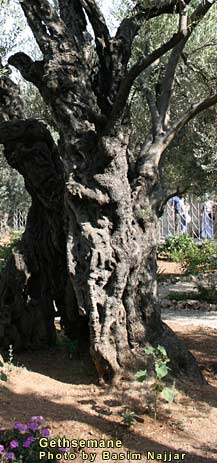
After eating his Last Supper in the city, Jesus and eleven disciples crossed the Kidron Valley. The monumental tombs we see there today (the cone-topped "Absalom's monument" and its neighbors) would have glowed in the light of the full Passover moon; these grand tombs were then recent by Jerusalem standards: none older than 200 years. They went "to the Mount of Olives," say Matthew, Mark and Luke, and the first two add, "to a place named Gethsemane." They went to the "other side" of the Kidron Valley, says John 18:1, "where there was a garden, in which He entered with His disciples." For as long as we know, Christians have located the site at the foot of the Mt. of Olives on the other side of the Kidron Valley: a location that fits all four gospels. Near the intersection between the busy valley road and the one that comes down from the mountain (a good candidate for the Palm Sunday route), we go down a flight of steps and find, next to Mary's tomb, a cave (or "grotto"). This may have been the site of the "olive press" to which the name Gethsemane refers (in Hebrew gat shmanim, "press of oils"). Tradition holds that this is the cave where Jesus left the eight, going a little farther with Peter, John and James. He then rejoined them. Here Judas found him, followed by the local authorities, and betrayed him with a kiss. Just up the hill from the cave, on the right, we find the entrance to the official Garden of Gethsemane. Around 380 AD, Christians built a church here, identifying a piece of bedrock as the place of Jesus' prayer. This must have been the "elegant church" that was new when the nun EgeriaName uncertain. A nun from the Atlantic coast, perhaps Spain, who visited the Holy Land in the late 4th century and described her journey in Latin for the sisters at home. She had a special interest in churches and Christian ritual. Only the middle of her Travels has survived, but it is a unique and valuable source. saw it. On Holy Thursday night, she wrote, "at the first cock's crow one descends [from the top of the mountain], singing hymns, to the place where the Lord prayed, as it stands in the Gospel: 'And he went a stone's throw away and prayed, etc.' In this place stands an elegant church." After the prayer, the hymn and the reading from the Gospel, she continues, "everyone, down to the smallest children, made the descent with the bishop to the foot, to Gethsemane," where they then read the passage describing "the Lord's arrest." Egeria's "Gethsemane" would have been the cave: it is indeed farther down, and a stone's throw away. In the successor to Egeria's "elegant church," the exposed bedrock is also the focus of the modern structure (built in 1924). The altar is of a limestone streaked with red, remembering the sweat that fell from Jesus like drops of blood (Luke 22:44Luke 22:44:And being in agony He was praying very fervently; and His sweat became like drops of blood, falling down upon the ground.). The alabaster in the windows keeps the inside rather dark, for the events occurred at night.
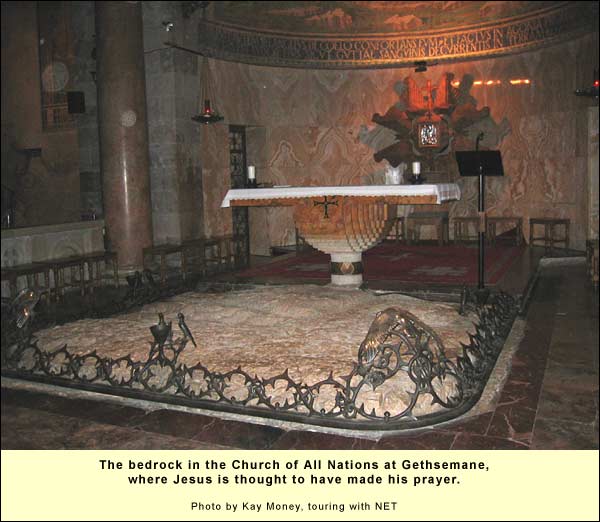
Under glass panels in the south aisle, we can still see bits of the first mosaic floor, and black circles mark the places of the Byzantine pillars. This church fell in the great earthquake of 749. The modern version bears the title, Church of All Nations: the seals of the nations whose Roman Catholics contributed toward its building are visible on the inner sides of its domes. It is also known as the Church of the Agony.
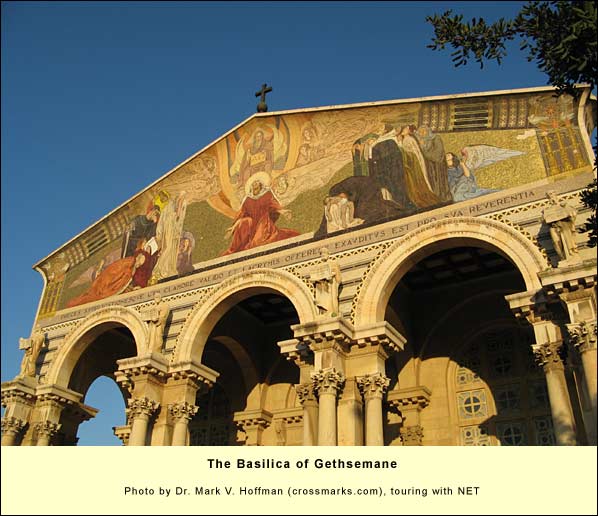
Logistics: The church and the cave are under Franciscan jurisdiction. Opening hours: Daily from 08:00-11:45 and 14:30-17:00 (18:00 in summer). Telephone: 02-6283264. Modest dressShoulders covered, legs covered below the knees. required. Jesus' Prayer at Gethsemane To consider the events at Gethsemane, the best place for a group is the private Franciscan garden across from the official one. Entrance must be arranged in advance. Here we can find a place on the grass amid olive trees and read the text and take time for silent meditation.
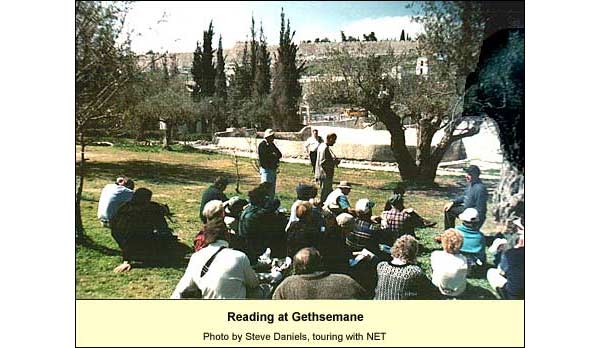
Matthew 26:36-46 Then Jesus came with them to a place called Gethsemane, and said to his disciples, “Sit here, while I go there and pray.” cb(26,37); He took with him Peter and the two sons of Zebedee, and began to be sorrowful and severely troubled. cb(26,38); Then he said to them, “My soul is exceedingly sorrowful, even to death. Stay here, and watch with me.” He went forward a little, fell on his face, and prayed, saying, “My Father, if it is possible, let this cup pass away from me; nevertheless, not what I desire, but what you desire.” He came to the disciples, and found them sleeping, and said to Peter, “What, couldn’t you watch with me for one hour? cj(26,41); Watch and pray, that you don’t enter into temptation. The spirit indeed is willing, but the flesh is weak.”
cb(26,42);Again, a second time he went away, and prayed, saying, “My Father, if this cup can’t pass away from me unless I drink it, your desire be done.” cb(26,43); He came again and found them sleeping, for their eyes were heavy. cb(26,44); He left them again, went away, and prayed a third time, saying the same words. cb(26,45); Then he came to his disciples, and said to them, “Sleep on now, and take your rest. Behold, the hour is at hand, and the Son of Man is betrayed into the hands of sinners. cj(26,46); Arise, let’s be going. Behold, he who betrays me is at hand.”
This prayer marks the beginning of the Passion. Paul calls Jesus the last Adam1 Corinthians 15:45: So also it is written, "The first man, Adam, became a living soul." The last Adam became a life-giving spirit., come to redeem the sin of the first. And what was the sin of the first? The eating of the fruit in the Garden of Eden. That can be interpreted as an act of self-assertion, of "I will." And here is Jesus, in a different garden, undoing that: "Not as I will, rather as you will." Here, in Christian belief, an age comes to fulfillment: the rupture that began in the Garden of Eden is healed in the Garden of Gethsemane.